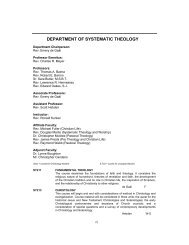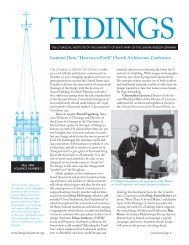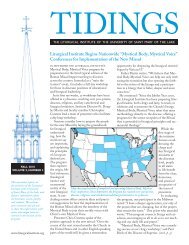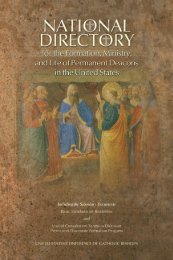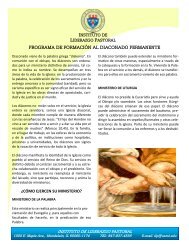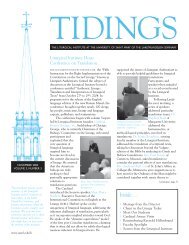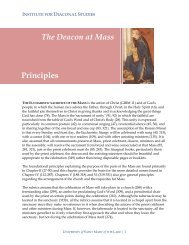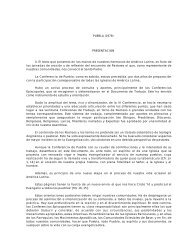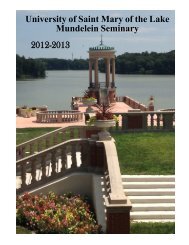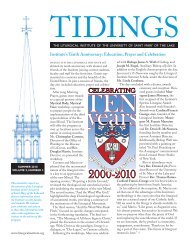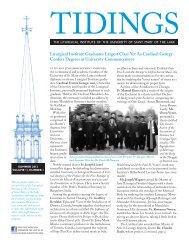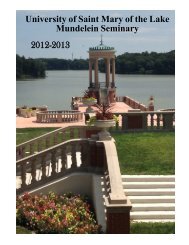Volume Six, Number 3, Fall 2007 - Mundelein Seminary
Volume Six, Number 3, Fall 2007 - Mundelein Seminary
Volume Six, Number 3, Fall 2007 - Mundelein Seminary
You also want an ePaper? Increase the reach of your titles
YUMPU automatically turns print PDFs into web optimized ePapers that Google loves.
tidings<br />
the liturgical institute of the university of saint mary of the lake/mundelein seminary<br />
Liturgical Institute Hosts “10 Things” Conference on Sacred Liturgy<br />
fall <strong>2007</strong><br />
<strong>Volume</strong> 6, <strong>Number</strong> 3<br />
This newsletter reports on<br />
the activities of the Liturgical<br />
Institute of the University<br />
of Saint Mary of the Lake/<br />
<strong>Mundelein</strong> <strong>Seminary</strong>, and features<br />
information about<br />
the Institute’s events, faculty,<br />
and students. We welcome<br />
your comments and ask you<br />
to share this information with<br />
others who might have an<br />
interest in the mission of this<br />
program.<br />
www.liturgicalinstitute.org<br />
in an effort to help pastors and their parish<br />
staffs understand the sacred liturgy’s theological<br />
foundations and expression in worship, the Liturgical<br />
Institute sponsored a conference entitled<br />
“10 Things Your Parish Needs to Know About<br />
the Sacred Liturgy” on October 5th and 6th,<br />
<strong>2007</strong>. It was intended to help invigorate parish<br />
life by addressing some of the most important<br />
and often asked questions about the nature and<br />
practice of the sacred liturgy.<br />
Keynote speaker Fr. Robert Barron of <strong>Mundelein</strong><br />
<strong>Seminary</strong> spoke of “Liturgy: The Life<br />
of the Church,” placing the Church’s liturgy in<br />
it’s long context of salvation history, from the<br />
law of the Old Testament to the prefiguring of<br />
heaven in our earthly liturgy. The Liturgical<br />
Institute’s own Fr. Douglas Martis spoke<br />
of the phrase “actual participation,” tracing<br />
its origins and explaining its meaning as<br />
expressed at the Second Vatican Council in<br />
the context of the 20th century Liturgical<br />
Movement. Fr. Thomas Milota, a priest<br />
of the Diocese of Joliet, Illinois, explained<br />
how the Mass is indeed the real, re-presented<br />
sacrifice of Jesus Christ as well as a<br />
meal which recalls the Last Supper, gathers<br />
the earthly community, and prefigures the<br />
Heavenly Banquet of the Lamb.<br />
In a cluster of talks aimed directly at<br />
the exercise of liturgical ministry, speakers<br />
addressed music, ritual and church<br />
documents. Liturgical Institute alumna<br />
Sr. Marganne Drago’s talk, “Don’t Sing<br />
at Mass, Sing the Mass,” addressed the<br />
wishes of 20th century liturgical reformers<br />
that active participation of the faithful<br />
center on singing the texts of the Mass itself. Fr.<br />
Dennis Gill of the Archdiocese of Philadelphia<br />
spoke of the richness of ritual, understanding the<br />
Church’s liturgical rites as more than a legalistic<br />
framework, but a treasure which amplifies what<br />
Catholic believe and therefore practice. Chris<br />
Carstens, Director of the Sacred Worship Office<br />
in the Diocese of LaCrosse, returned to address<br />
the Church’s documentation, digging beneath<br />
the protective rules to establish them as “exciting<br />
sources of theology.”<br />
Conference presenter Sheila Liaugminas speaks with conference<br />
participants after her talk entitled “The Domestic Church: Liturgy<br />
and Everyday Life.”<br />
Institute faculty member Dr. Denis McNamara’s<br />
talk, “How to Read a Church Building,”<br />
asked participants to see the church as a sacramental<br />
thing which recalls the Old Testament<br />
temple worship, marks the Christian community<br />
in a place, and serves as an image of the Heavenly<br />
Jerusalem. <strong>Mundelein</strong> <strong>Seminary</strong>’s Director of<br />
Liturgy, Fr. John Szmyd, explored how progressive<br />
solemnity can clarify the relative importance<br />
of the Church’s liturgical feasts and seasons. Dominican<br />
Father Peter Gerard addressed the topic<br />
of how to listen to a homily, exploring the life<br />
changing possibilities of preaching the Word of<br />
God. Franciscan University’s Prof. James Pauley<br />
then explored the necessary and fruitful relationship<br />
between liturgy and the catechesis necessary<br />
to help people understand it and therefore participate<br />
fully and actively. Lastly, Relevant Radio’s<br />
Sheila Liaugminas offered suggestions for bringing<br />
the fruits of the liturgy to everyday life.<br />
The Institute’s conferences address all facets<br />
of the Church’s liturgical life, theological, pastoral,<br />
and practical. Please view the upcoming<br />
conferences listed in this issue of Tidings and<br />
consider attending in the future.
Fr. Douglas Martis, a priest of<br />
the Diocese of Joliet, holds an<br />
S.T.D. with a concentration in<br />
Sacramental Theology from the<br />
Institut Catholique de Paris and<br />
a Ph.D. in History of Religions<br />
and Religious Anthropology<br />
from the Sorbonne.<br />
From the Director<br />
the autumn term at mundelein is always<br />
exciting. New students arrive from all corners<br />
of the globe, returning students come with new<br />
enthusiasm and offer renewed hope.<br />
The Liturgical Institute staff has had this<br />
year the opportunity to participate in events<br />
both on campus and around the country: Dr.<br />
McNamara with keen insight into church<br />
architecture, Linda Cerabona with her commitment<br />
to honoring previous music directors<br />
at <strong>Mundelein</strong>, always learning from the past,<br />
moving with greater fidelity and reverence for<br />
the liturgy, and Kevin Thornton, manager for<br />
Hillenbrand Books, with his constant pursuit of<br />
new authors and new projects. I have personally<br />
had the opportunity to meet parishioners, clergy,<br />
a professional liturgists around the country who<br />
have shared their excitement and reverence for<br />
the liturgy. In a particular way, my meetings with<br />
undergraduates to whom I have had the opportunity<br />
to present the different degree programs<br />
offered by the Institute have served to motivate<br />
me and sustain me in this work. We are also<br />
proud to announce that several Liturgical Institute<br />
students have published scholarly articles,<br />
thus contributing in another way to the renewal<br />
of the liturgy in the Church.<br />
This issue of Tidings chronicles some of<br />
the events that have taken place on our campus.<br />
Rev. Dennis Gill, who will be teaching for the<br />
Institute in the summer session, presented the<br />
Hillenbrand Lecture on Pope Benedict’s recent<br />
motu proprio. In this issue of Tidings, Dr. Lynne<br />
Boughton offers her own reflection on Summorum<br />
pontificum.<br />
The Liturgical Institute’s conferences in the<br />
past few months have brought together men and<br />
women from many places. They have prayed, reflected<br />
and learned about the liturgy. They bring<br />
home with them a renewed sense of the sacred<br />
and a deeper appreciation for the liturgy. They<br />
leave us with growing resolve to continue the<br />
mission of the Institute with new ideas and new<br />
opportunities.<br />
These people and events give us a strong<br />
sense that the vision of liturgical renewal is ever<br />
new and ever timely. The work is invigorating<br />
and valuable. It is crucial for the new generation<br />
of the Church and we are glad to be part of<br />
it. Each person we have met, each one who has<br />
participated in our conferences, academic programs,<br />
special projects and books, has given us<br />
input that is important as we continue our work.<br />
Others have made financial contributions that<br />
allow access to those who might not otherwise<br />
be able to attend. And some major donors have<br />
made copies of the <strong>Mundelein</strong> Psalter available<br />
both for seminarians and Liturgical Institute<br />
students to foster their liturgical prayer. For all<br />
this we are profoundly grateful. <br />
upcoming events at the liturgical institute<br />
January 18, 2008 Treasures of the Triduum<br />
A one-day workshop which unveils the rich theology of the apex of the Church’s liturgical year. Perfect for preachers, liturgy<br />
directors, musicians, parishioners and all who desire to enter more deeply into the heart of the Paschal Mystery. With workshop<br />
leaders Fr. Douglas Martis of the Liturgical Institute and Rev. Michael Fuller of <strong>Mundelein</strong> <strong>Seminary</strong>.<br />
April 2-3, 2008 Liturgy, Justice and Social Reconstruction<br />
A conference which examines and reclaims the intimate link between the Sacred Liturgy and Christ’s reign of peace and justice<br />
flourishing in a society built on Christian principles and transformation of individuals through grace in the sacraments. With<br />
keynote speaker Rev. Richard John Neuhaus.<br />
June 22-27, 2008 Sacred Music Retreat<br />
The Institute’s third music retreat welcomes veteran Church musician Fr. Greg Labus as retreat master. A true preached retreat on<br />
the ministry of liturgical music with spiritual talks, time for prayer and reflection, Mass and sung Liturgy of the Hours, the event<br />
is a must for musicians who want to renew their souls and place their ministry in proper theological context.<br />
September 19-20, 2008 The Bible and the Liturgy: Written Text Becomes Living Word<br />
Join Dr. Scott Hahn, Fr. Robert Barron, Dr. John Cavadini, Mr. Jeff Cavins, Dr. David Fagerberg, Dr. Brant Pitre, and the Liturgical<br />
Institute’s own Fr. Douglas Martis and Dr. Denis McNamara and others for a scholarly and popular look at the Biblical<br />
foundations of the Catholic liturgy. Enrollment limited.<br />
For more information call 4..4542 or visit www.liturgicalinstitute.org
Fr. Peter Cameron, op Returns for “Profound Preaching”<br />
Fr. Peter John Cameron, OP returns to the<br />
Liturgical Institute for his second “Profound<br />
Preaching” workshop.<br />
after the success of his 2005 preaching<br />
workshop of the same name, the Liturgical<br />
Institute welcomed the return of Fr.<br />
Peter John Cameron, op to offer an allnew<br />
workshop on the spirituality and<br />
practice of preaching. With nearly 120<br />
priests and deacons from over a dozen<br />
dioceses, the conference proved again to<br />
be one of the Institute’s most popular<br />
events. Cameron, who is the founding<br />
editor of Magnificat magazine, teaches<br />
homiletics at the Dominican House<br />
of Studies in Washington, DC and<br />
is the author of To Praise, To Bless, To<br />
Preach: Spiritual Reflections on the Sunday<br />
Gospels.<br />
Fr. Cameron’s workshop consisted<br />
of four sections, with the first two<br />
beginning with Pope Benedict XVI’s<br />
encyclical letter Deus Caritas Est. Cameron<br />
asked participants to consider using<br />
the appeal to the experience of their listeners,<br />
primarily concerning their experience of Christ,<br />
which is “not a result of an ethical choice or lofty<br />
idea, but the encounter with an event, a person.”<br />
Cameron asked the attendees to consider the<br />
meaning of the words “event” and “encounter,”<br />
suggesting that the encounter is the Christian<br />
method for knowing God, and that preaching<br />
must offer a proposal which addresses the Good<br />
News and the faithful’s question “How do I apply<br />
this to my life”<br />
In session three, Fr. Cameron turned his attention<br />
to the concept of homiletic imagination,<br />
arguing that the mental picture is a key method<br />
for helping the hearers of a homily understand<br />
the message. He chose definitions of imagination<br />
from Aristotle, Pascal, Einstein, and even Tennessee<br />
Williams. Imagination in this case was<br />
not fantasy per se, but the power of the mind to<br />
conceive of things as they ought to be.<br />
Finally, Cameron addressed the Gospels of<br />
the upcoming liturgical cycle, touching on the<br />
fundamental questions of each Sunday and feast,<br />
and culling from each reading an “implied lived<br />
question” about which priests and deacons could<br />
pray and preach.<br />
In order to demonstrate the Liturgical<br />
Institute’s deep connection between practical,<br />
academic and spiritual development, the day’s<br />
sessions were punctuated by sung Morning,<br />
Midday and Evening prayer in the university’s<br />
grand Chapel of the Immaculate Conception<br />
with prayer settings from The <strong>Mundelein</strong> Psalter.<br />
<br />
Hillenbrand Books Announces New Title<br />
In 1828, theology professors in the German university city of Freiburg issued a provocative statement<br />
calling for the abolition of mandatory celibacy for Catholic priests. They advanced two arguments,<br />
first, that celibacy was no longer up-to-date and second, there was a pressing shortage of priests.<br />
Young theologian and priest, Johann Adam Möhler responded with an article called “Illumination<br />
on a Memorandum Concerning the Elimination of Celibacy Prescribed for Catholic Priests.” The<br />
consequence of Möhler’s article was a dramatic rise in vocations to the priesthood. Young men of all<br />
walks of life rediscovered priesthood as a way of following Christ and making him present to others.<br />
This book is the first English translation of this classic work on celibacy and speaks well to<br />
modern day concerns about priestly celibacy and the priest shortage. An insightful commentary by<br />
theologian and professor Dieter Hattrup of the University of Paderborn sheds more light into this<br />
discussion, making this a wonderful addition to priestly formation, sacramental and Holy Orders<br />
courses or for anyone concerned about celibacy and the priesthood.<br />
Johann Adam Möhler (1796-1838) was a professor of Church history, canon law and apologetics<br />
at Tübingen University. He developed an ecumenical sensitivity which led him to write the famous<br />
Symbolik, which catapulted him to academic prominence. He also wrote On the Unity of the Church<br />
(1825) and Athanasius the Great and the Church of His Time (1827). These three books rank him, along with Scheeben and Newman,<br />
among the greatest Catholic theologians of the 19th century.<br />
To order The Spirit of Celibacy visit www.ltp.org or call 1.800. 933.1800.<br />
“Johann Adam Möhler’s spirited defense of clerical celibacy poses a welcome challenge to contemporary reflection. Möhler not only refutes<br />
the arguments in favor of clerical marriage; he also puts forward with passionate conviction his thesis that celibacy is a spiritual necessity<br />
for the priest.” —Sara Butler, msbt, Professor of Dogmatic Theology, St. Joseph’s <strong>Seminary</strong>, Archdiocese of New York
Rev. Dennis Gill Gives Hillenbrand Lecture on Summorum Pontificum<br />
Fr. Dennis Gill of the Archdiocese of Philadelphia<br />
offers his thoughts on Pope Benedict’s Apostolic Letter<br />
Summorum Pontificum.<br />
as part of the hillenbrand distinguished<br />
Lecture Series, Fr. Dennis Gill addressed<br />
the meaning of Pope<br />
Benedict’s recent Apostolic<br />
Letter Summorum<br />
pontificum. Ever mindful<br />
of the teaching of the<br />
Church in matters of<br />
liturgy, the Liturgical<br />
Institute offered the lecture<br />
to its own students,<br />
faculty, seminarians, and<br />
the larger community.<br />
Currently a doctoral<br />
student in sacramental<br />
theology at the<br />
Pontifical Athenaeum<br />
Sant’Anselmo in Rome,<br />
Fr. Gill has served<br />
previously as Director of<br />
Liturgy for the Pontifical<br />
North American College<br />
in Rome and as Associate<br />
Director of the Office<br />
of Worship for the Archdiocese<br />
of Philadelphia.<br />
Gill began by<br />
discussing Benedict’s<br />
address of December 22, 2005 in which he<br />
spoke of the two hermeneutics after the Second<br />
Vatican Council, one of continuity and one of<br />
discontinuity. Gill spoke of Benedict’s assertion<br />
that there is one liturgy, one subject which is<br />
always the same. Therefore, one must avoid the<br />
tendency to see a split between pre-conciliar and<br />
post-conciliar liturgical books.<br />
In Summorum pontificum, Gill argued, one<br />
finds an attempt to build bridges to reconnect<br />
with the received tradition because liturgy<br />
lives and develops organically from one age to<br />
another. Fellowship with previous generations is<br />
therefore something we can actually experience<br />
through liturgical continuity.<br />
Gill was careful to assert that Summorum<br />
Pontificum allows a two-fold use of the same rite,<br />
and cautioned his audience against thinking of<br />
the Missals of John XXIII and Paul VI as separate<br />
rites. He also emphasized that the usage of<br />
the extraordinary form of the rite was optional,<br />
not obligatory.<br />
Gill concluded by telling his listeners that<br />
Summorum Pontificum is not an attempt to “go<br />
backward,” but a decidedly post-conciliar event<br />
in the context of the Church’s self-understanding<br />
with and since the Council. He also argued that<br />
the motu proprio was not a permanent solution<br />
to the problems which have arisen in liturgy<br />
since the Council, but that it would work in<br />
union with other liturgical instructions given to<br />
the Church in recent years. Last, he urged charity<br />
among all involved in the liturgical renewal<br />
envisioned by the Second Vatican Council so<br />
that Summorum pontificum might have a “serene<br />
reception.” <br />
The <strong>Mundelein</strong> Psalter in Second Printing<br />
in its effort to help renew the liturgical life of the church, the Liturgical Institute’s Hillenbrand Books released in<br />
May of <strong>2007</strong> The <strong>Mundelein</strong> Psalter, the first complete one-volume edition containing the approved English-language texts of the<br />
Liturgy of the Hours that are pointed for chanting the Divine Office. Response to the Psalter<br />
has been even greater than predicted, with the psalter’s web site, mundeleinpsalter.com, receiving<br />
thousands of visits to utilize on-line resources there such as music downloads and instructions<br />
for singing the Divine Office. With orders exhausting the first printing in only six months, the<br />
second printing was released in November of <strong>2007</strong>. The Psalter has already been ordered by<br />
seminaries, religious communities, individuals, and by multiple parishes to begin the public praying<br />
of the Divine Office.<br />
Edited by Liturgical Institute Director Fr. Douglas Martis, the Psalter offers simple yet beautiful<br />
Gregorian-based modes composed for English singing by Fr. Samuel Weber, osb, a monk<br />
of St. Meinrad Archabbey and founding faculty member of the Wake Forest Divinity School.<br />
The Psalter offers proper hymns with their ancient modal settings for each ferial day as well as a<br />
selection of hymns for feasts and solemnities from the editio typica.<br />
To order the <strong>Mundelein</strong> Psalter, contact Liturgy Training Publications at 1.800.933.1800 or<br />
www.ltp.org. More information on the Psalter can be found at www.mundeleinpsalter.com.<br />
Be sure to mention the Tidings discount code 8MST11 to receive 20% off list price!
Dr. Lynne Boughton is an adjunct faculty<br />
member of the Liturgical Institute.<br />
Two Expressions of the Roman Rite: Summorum pontificum<br />
pope gregory the great (590-604) explained in a letter to the Bishop of Syracuse that<br />
preserving continuity of Roman liturgy with apostolic tradition is ultimately the responsibility of the<br />
papacy. Gregory noted that he curtailed a custom, among priests celebrating Mass in Rome, of reciting<br />
the “Our Father” after breaking the consecrated host because their doing so placed this prayer outside<br />
the rite’s canon/anaphora and deviated from ancient practice. Recitation of the entire Kyrie by congregations,<br />
as was done in Constantinople, was also judged by Gregory to have departed from tradition<br />
and he promised that in Rome priests and laity would continue to alternate in voicing each of the<br />
prayer’s nine pleas for God’s mercy.<br />
The solicitude of Gregory and other pontiffs for the Roman Rite is the underlying principle that<br />
governs Summorum pontificum (hereafter: SP), an Apostolic Letter issued by Pope Benedict XVI (7 July<br />
<strong>2007</strong>). In this motu proprio Benedict continues the work of his predecessors by explaining that the rite<br />
that they nurtured has now developed into two tangible forms. Each transmits the supernatural gifts<br />
and central act of worship that Jesus entrusted to the Apostles and each demands from the Church<br />
the same degree of reverence and reflection. SP affirms that every priest in good standing who has<br />
been ordained in the Roman Rite has the canonical right – and has never been deprived of the right – to offer Mass, either alone or with<br />
a congregation, in the liturgical form that: 1.) appeared in its basic structure and content more than two centuries before Gregory’s pontificate;<br />
2.) was transcribed in successive sacramentaria and missali between the 6th and 19th centuries; and 3.) was most recently issued by Pope<br />
John XXIII as the 1962 Missale Romanum (MR). Benedict emphasizes that this eucharistic form remains as much the Church’s expression of<br />
her theology as the 1969/1970 MR that was instituted after the Second Vatican Council (1962-65) and is now in its third edition. Although<br />
Benedict expects the form of Mass, manner of conferring other sacraments, and way of praying the Divine Office that originated after<br />
Vatican II to remain “ordinary” manifestations of the Roman Rite, he urges that the “venerable and ancient usage” preserved by the form of<br />
Mass and other liturgical actions that developed prior to that council be available as “extraordinary” expressions of the same Catholic faith.<br />
Because the papacy safeguards the “uninterrupted apostolic tradition” that the Church has received, Benedict declares that the liturgical<br />
form which predated Vatican II has never been juridically prohibited. Although, several authoritative entities in the Church have ruled<br />
that the 1962 MR may be used only in seclusion by elderly and infirm priests, no papal decree has imposed this restriction. Pope Paul VI<br />
responded positively to a request from the diocese of Westminster for regular celebration of the 1962 MR and rulings from Pope John Paul<br />
II not only exhorted bishops to be generous in allowing priests to offer this Mass but established new institutes and communities of priests<br />
dedicated to celebrating all components of the pre-Vatican II liturgical form. The key restriction has been that there be no intermingling, in<br />
any particular celebration, of the structures, rubrics, or ministries characteristic that developed within one form of the rite with those that<br />
developed within the other. Although the objectives of SP are clear, discussions of its content are often misleading. Some have evaluated the<br />
document as though it were merely a disciplinary ruling regarding use of the “Tridentine Rite” vis-à-vis the “Vatican II Rite” – with ensuing<br />
commentary expressing joy, indifference, or consternation at this turn of events. Such discussions overlook SP’s explanation that there are not<br />
two competing “rites” but two harmonious expressions of a single Rite, and also ignore SP’s illuminating language.<br />
For example, Benedict does not identify the 1962 MR as “Tridentine.” Although this MR is, except for the revised Paschal Triduum<br />
(1955), almost identical to the 1570 MR issued by Pope Pius V after the Council of Trent (1545-63), the 1570 MR was not a Tridentine innovation<br />
but a reissue of the 1474 MR with a few changes in calendar, rubrics, and propers assigned to particular feasts. The 1474 MR, in turn,<br />
parallels the 12th/13th century missale of the Roman curia. Moreover, the Mass common to all these missali is presented from beginning to<br />
end in the Stowe Missal, an 8th century transcription of the ordo missae and Roman Canon present in every Roman Rite Mass by the late<br />
6th century along with propers of a single feast. SP similarly eschews classifying the 1970 MR as the rite of “Vatican II.” Certainly, the 1970<br />
MR departs from all preceding missali in allowing options within the ordo missae and in eliminating or making optional certain propers while<br />
expanding others. Nevertheless, the 1970 MR retains most prayers from the prior form of ordo missae and its Eucharistic Prayer #1, varies<br />
only slightly from the Roman Canon that serves as the only anaphora in the 1962, 1570, and 1474 MR, the curial missal, the Old Gelasian Sacramentary<br />
(7th century), the Stowe, and was cited c. 380 by St. Ambrose. And, of course, in both the ordinary and extraordinary forms, the<br />
Words of Institution are those of Jesus, preserved for all time in the three Synoptic Gospels and in a letter of Paul.<br />
Although some maintain that SP’s recognition of each priest’s right to offer the extraordinary form applies only to “private” celebrations,<br />
this misreads the document. Benedict never refers to “private” Mass because, as Pope Paul VI (citing St. John Damascene) noted, “Every<br />
Mass even though a priest may offer it in private is not a private matter; it is an act of Christ and the Church.” Benedict’s reference in SP<br />
art. 2 to missis sine populo celebratis (“Masses celebrated without a congregation”) does not restrict priests to celebrating the 1962 MR only<br />
in seclusion. Instead, the passage merely prohibits offering either the 1962 MR or the 1970 MR without a congregation during the Paschal<br />
Triduum. In SP art. 4, Benedict affirms that any priest may offer Mass in the extraordinary form among christifideles qui sua sponte id petunt<br />
(“Christian faithful who, of their own will, ask to attend”).<br />
Congregations present at the extraordinary form of Mass are permitted traditional methods of external as well as interior participation.<br />
In the 13th century St. Thomas Aquinas noted that congregations chanted the Credo, Sanctus and other fixed prayers. In 1501 the papal<br />
chaplain advised that in recited Masses, the interessentes (congregation) were to reply audibly to the priest in alternating the verses of the<br />
introductory psalms, the Kyrie, and the “Lift up your hearts” dialogue. The laity were also to voice with the priest-celebrant the entire Confiteor,<br />
Gloria, Credo, Sanctus, and Agnus Dei. In 1903 Pope Pius X urged congregations to participate in the Gregorian chant that made these<br />
prayers and affirmations audible in sung Masses.<br />
Like others who have occupied the Chair of St. Peter, Benedict affirms that what the Church has preserved through the course of centuries<br />
is not her own creation but is a treasure entrusted to her by God to be cherished and made available to people inhabiting all times and<br />
places. SP manifests Benedict’s conviction that in both forms of the Mass of the Roman Rite ordained priests effect a divine actio that makes<br />
present Jesus’ propitiatory sacrifice and substantial presence as God and man. Both forms of this living reality, as well as of the sacraments<br />
and daily office that developed in conjunction with them, are to be welcomed by the Church with reverence and joy.
Scenes from the Liturgical Institute<br />
(left to right): Liturgical Institute Music Director Linda Cerabona welcomes faculty and staff to dinner; Institute faculty member Denis McNamara<br />
explains the sacramental theology behind the University’s Chapel of the Immaculate Conception; students, staff and faculty gather for a meal.<br />
(left to right): Fr. Thomas Milota speaks on “The Mass as Sacrifice and Meal”; Celebratory dinner for All Saints Day; Institute Director Fr. Douglas<br />
Martis teaches the fundamentals of chanting the Divine Office.<br />
TIDINGS<br />
university of saint mary of the lake<br />
the liturgical institute<br />
000 East Maple Avenue<br />
<strong>Mundelein</strong>, Illinois 60060<br />
www.liturgicalinstitute.org<br />
Nonprofit Organization<br />
u.s. postage paid<br />
mundelein, il<br />
permit no. 103



